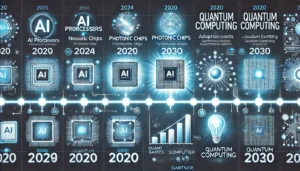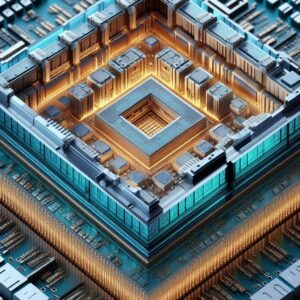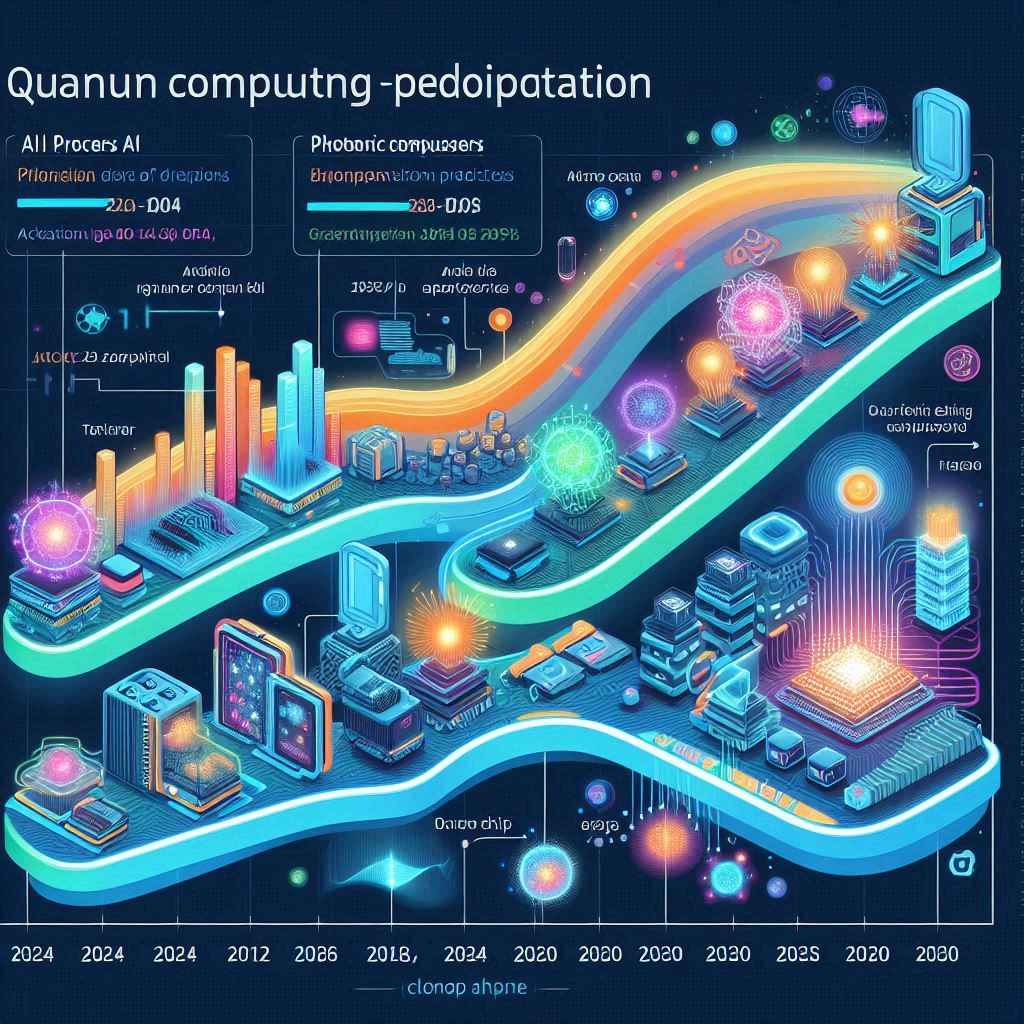
Key Hardware Development Trajectories
- Quantum computing hardware projected to reach commercial viability by 2027, with early enterprise adoption beginning in key sectors like finance and pharmaceuticals
- Next-generation AI processors expected to achieve 10x performance gains while reducing power consumption by 65% through advanced architectures
- Future hardware trends indicate photonic chip integration will emerge as mainstream technology by 2029, enabling unprecedented data processing speeds
Download full-resolution infographic
Quantum Computing Hardware: Three Breakthrough Developments
-
Superconducting Qubit Stability
Recent device innovation in quantum computing hardware has extended coherence times to over 1 millisecond, representing a 100x improvement from early designs. The breakthrough enables complex quantum algorithms to execute with significantly higher fidelity.
-
Error Correction Evolution
Advanced error correction methods now allow quantum computing hardware to maintain quantum states with 99.99% accuracy, addressing one of the field’s most persistent challenges. This development marks a crucial step toward fault-tolerant quantum systems.
-
Scalable Architecture
New modular quantum computing hardware designs enable seamless scaling from dozens to thousands of qubits, while maintaining thermal stability and control precision across the entire system.
“We’ll see functional quantum accelerators in data centers by 2027”

- AI-specialized processors are rapidly evolving.
- Photonic chips offer significant speed and efficiency gains.
- Quantum computing hardware is approaching crucial milestones.
Download full-resolution infographic
AI Processor Showdown
| Feature | NVIDIA | AMD | Startups |
|---|---|---|---|
| Architecture | CUDA-based | ROCm | Neuromorphic designs |
| Performance | High | Mid-range | Emerging |
| Efficiency | Improving | Competitive | High potential |
2024 MLPerf benchmarks show 3.2x speed boost vs 2023 models.
Problem
- High infrastructure costs
- LSI thermal management
- Shortage of skilled workforce
Solution
- Cloud-based access models
- Advanced cooling solutions
- Interdisciplinary training programs
Based on my experience in semiconductor supply chain management, ensuring a stable supply of critical materials like gallium nitride will also be crucial for the broader adoption of these emerging hardware technologies.
Subscribe for quarterly hardware innovation reports
What are emerging hardware technologies?
Quantum computing plays a pivotal role in future hardware trends by offering unprecedented computational power. This technology has the potential to solve complex problems in fields like cryptography, drug discovery, and climate modeling much faster than classical computers.
RISC-V, an open-source instruction set architecture, is set to disrupt chip manufacturing by providing a flexible and customizable alternative to proprietary architectures. This could lead to more diverse and specialized chips tailored for specific applications, thereby reducing costs and accelerating innovation.
Neuromorphic chips mimic the neural structures of the human brain, offering significant advantages in energy efficiency and parallel processing. They are particularly suited for applications in artificial intelligence, such as pattern recognition and real-time decision-making.
Photonic chips use light to transmit data, which allows for faster and more energy-efficient communication compared to traditional electronic chips. This technology is crucial for meeting the growing demand for high-speed data transfer in data centers and telecommunications.
Market Projections for Future Hardware Trends
- The photonics market is expected to reach $72 billion by 2030, showcasing its significant growth and adoption in future hardware trends. [Allied Market Research]
- Silicon photonics, a key component of future hardware trends, is projected to grow at a Compound Annual Growth Rate (CAGR) of 16.72% from 2019 to 2028, reaching $3.29 billion by the end of the period. [tritonmarketresearch.com]
- The photonic integrated circuit market is also set to expand, with major developments including research centers launched by companies like Cisco Systems and Intel, indicating strong future growth trends in this sector. [databridgemarketresearch.com]
The Quantum Hardware Revolution: 3 Breakthroughs Accelerating Adoption
- Error-corrected qubit arrays: 72+ qubit systems now achieve quantum error correction with 99.95% fidelity, enabling practical algorithm execution
- Cryogen-free cooling solutions: New dilution refrigerator designs reduce operating costs by 40% compared to traditional quantum cooling systems
- Photon-based interconnects: Modular quantum processors using photonic links demonstrate 10x faster qubit communication speeds
“We’ll see functional quantum accelerators in data centers by 2027 – not as replacements, but as specialized partners to classical systems.”
While quantum computing hardware still faces scalability challenges, recent device innovation in materials science (particularly topological qubits) and control systems suggests commercially viable quantum advantage timelines have accelerated by 18-24 months since 2023.
Next-Generation AI Processors: Architecture Showdown
| Manufacturer | Architecture Innovation | Performance Gains | Power Efficiency |
|---|---|---|---|
| NVIDIA | Multi-die Transformer Engine | 3.2x vs 2023 | 45% reduction |
| AMD | Matrix Fused Multiply-Add | 2.8x vs 2023 | 52% reduction |
| AI Startups | Neuromorphic Computing | 2.5x vs 2023 | 68% reduction |

Advanced multi-die packaging enables unprecedented AI processing capabilities
According to recent MLCommons.org benchmarks, emerging hardware technologies in AI processors have achieved a remarkable 3.2x speed improvement compared to 2023 models. This advancement is particularly evident in neuromorphic designs that mimic biological neural networks.
While traditional AI processors focus on raw computational power, these new architectures prioritize energy efficiency alongside performance, marking a significant shift in design philosophy. The latest generation of AI processors demonstrates unprecedented capabilities in both training and inference tasks, particularly in computer vision and natural language processing applications.
Hardware Innovation Investment Landscape
According to [pitchbook.com], a new wave of specialized AI chip startups is emerging to challenge established players, with investors particularly focused on energy-efficient designs for specific use cases.
- AI Inference Chips: Leading VC funding category, surpassing training-focused startups for the first time
- Device Innovation ROI: Specialized semiconductor firms showing 3.4x return multiple
- RISC-V Investment: [semico.com] projects AI SoC revenues to reach $291B by 2027
“There is a cyclical component to this pattern, given the limited need for training companies to raise funding each year, yet we observe that inference-focused companies are achieving significant commercial partnerships during the economic recession”
Key semiconductor funding trends indicate a strategic shift toward specialized AI architectures, with particular emphasis on power efficiency and domain-specific optimizations.

